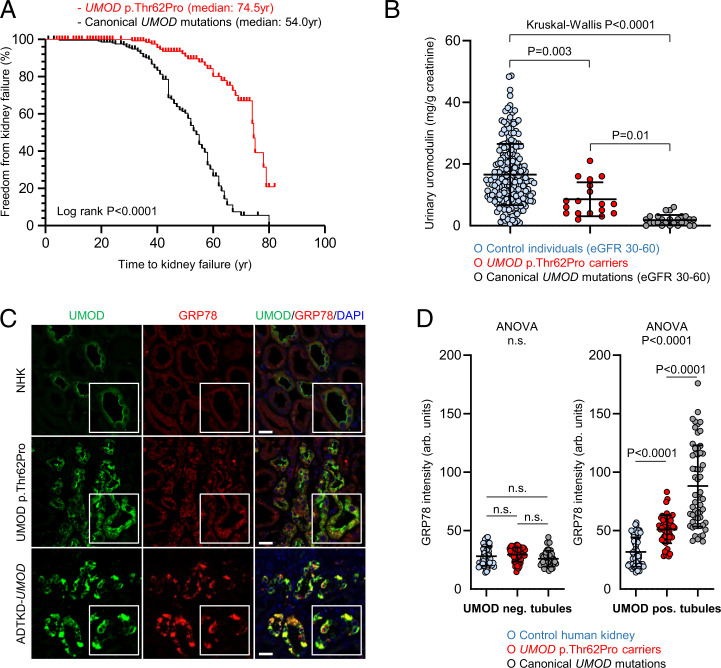Fig. 4.
Mild kidney disease phenotype and intermediate UMOD trafficking defect and ER stress in p.Thr62Pro carriers. (A) Kaplan–Meier curves of renal survival in all p.Thr62Pro carriers identified in Genomics England 100,000 Genomes Project data and in p.Thr62Pro-positive families/cases with CKD (n = 157) compared with ADTKD-UMOD patients from the International ADTKD Cohort (n = 225). Only patients with confirmed p.Thr62Pro status have been included in the analysis. Median age at kidney failure was 74.5 y in UMOD p.Thr62Pro carriers and 54.0 y in ADTKD-UMOD patients with canonical UMOD mutations. (B) Urinary UMOD levels normalized to urinary creatinine are depicted for control individuals matched for eGFR (30 to 60 mL/min per 1.73 m2), UMOD p.Thr62Pro carriers, and ADTKD-UMOD patients with canonical UMOD mutations matched for eGFR (30 to 60 mL/min per 1.73 m2). Outlier removal was performed using Robust regression and Outlier removal (ROUT) method (Q = 1%). The graph depicts individual values, and bars indicate mean ± SD. The Kruskal–Wallis test was used with Dunn's multiple comparisons test. (C) Immunofluorescence staining for UMOD (green) and GRP78 (red) in normal human kidney (NHK; from a tumor nephrectomy), a UMOD p.Thr62Pro human kidney biopsy, and kidney tissue from an ADTKD-UMOD patient with a canonical UMOD mutation (p.Arg185Ser). Insets show UMOD-expressing tubules at higher magnification. DAPI, 4′,6-diamidino-2-phenylindole. (Scale bars, 25 μm). (D) Quantification of the fluorescent signal intensity for ER stress–associated GRP78 in UMOD-negative and UMOD-positive tubules from three NHK samples (tumor nephrectomy), three p.Thr62Pro kidney biopsies, and three ADTKD-UMOD kidney samples. Further details can be found in SI Appendix, Table S9. The graph depicts tubule values in arbitrary units, and bars indicate mean ± SD. One-way ANOVA was followed by Tukey’s multiple comparison test. ns, not significant.

